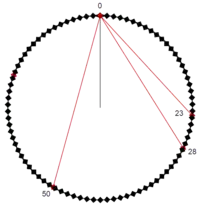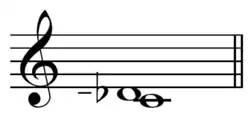Delta scale
The δ (delta) scale is a non-octave repeating musical scale. It may be regarded as the beta scale's reciprocal since it is, "as far 'down' the (0 3 6 9) circle from α as β is 'up.'"[1] As such it would split the minor second (presumably 16:15) into eight equal parts of approximately 14 cents each ![]() Play . This would total approximately 85.7 steps per octave.
Play . This would total approximately 85.7 steps per octave.


The scale step may also precisely be derived from using 50:28 (25:14, 1003.8 cents, A![]() ♯,
♯, ![]() Play ) to approximate the interval 3:2⁄5:4, which equals 6:5 (E♭, 315.64 cents,
Play ) to approximate the interval 3:2⁄5:4, which equals 6:5 (E♭, 315.64 cents, ![]() Play ). Thus the step is approximately 13.946 cents and there are 86.049 per octave.
Play ). Thus the step is approximately 13.946 cents and there are 86.049 per octave.
(![]() Play )
Play )
The Bohlen–Pierce delta scale is based on the tritave and the 7:5:3 "wide" triad (![]() Play ) and the 9:7:5 "narrow" triad (
Play ) and the 9:7:5 "narrow" triad (![]() Play ) (rather than the conventional 4:5:6 triad). Notes include:[2]
Play ) (rather than the conventional 4:5:6 triad). Notes include:[2]
| interval name | size (steps) |
size (cents) |
just ratio | just (cents) |
error |
| minor third | 23 | 321.23 | 6:5 | 315.64 | +5.59 |
| major third | 28 | 391.06 | 5:4 | 386.31 | +4.75 |
| perfect fifth | 50 | 698.32 | 3:2 | 701.96 | -3.63 |
See also
Further reading
- Bohlen, Heinz: "13 Tonstufen in der Duodezime", Acustica, vol. 39 no. 2, S. Hirzel Verlag, Stuttgart, 1978, pp. 76 – 86. (in German)
Sources
- Taruskin, Richard (1996). Stravinsky and the Russian Traditions: A Biography of the Works through Mavra, p.1394. ISBN 978-0-520-07099-8.
- "What about BP tonality?", The Bohlen-Pierce Site.


